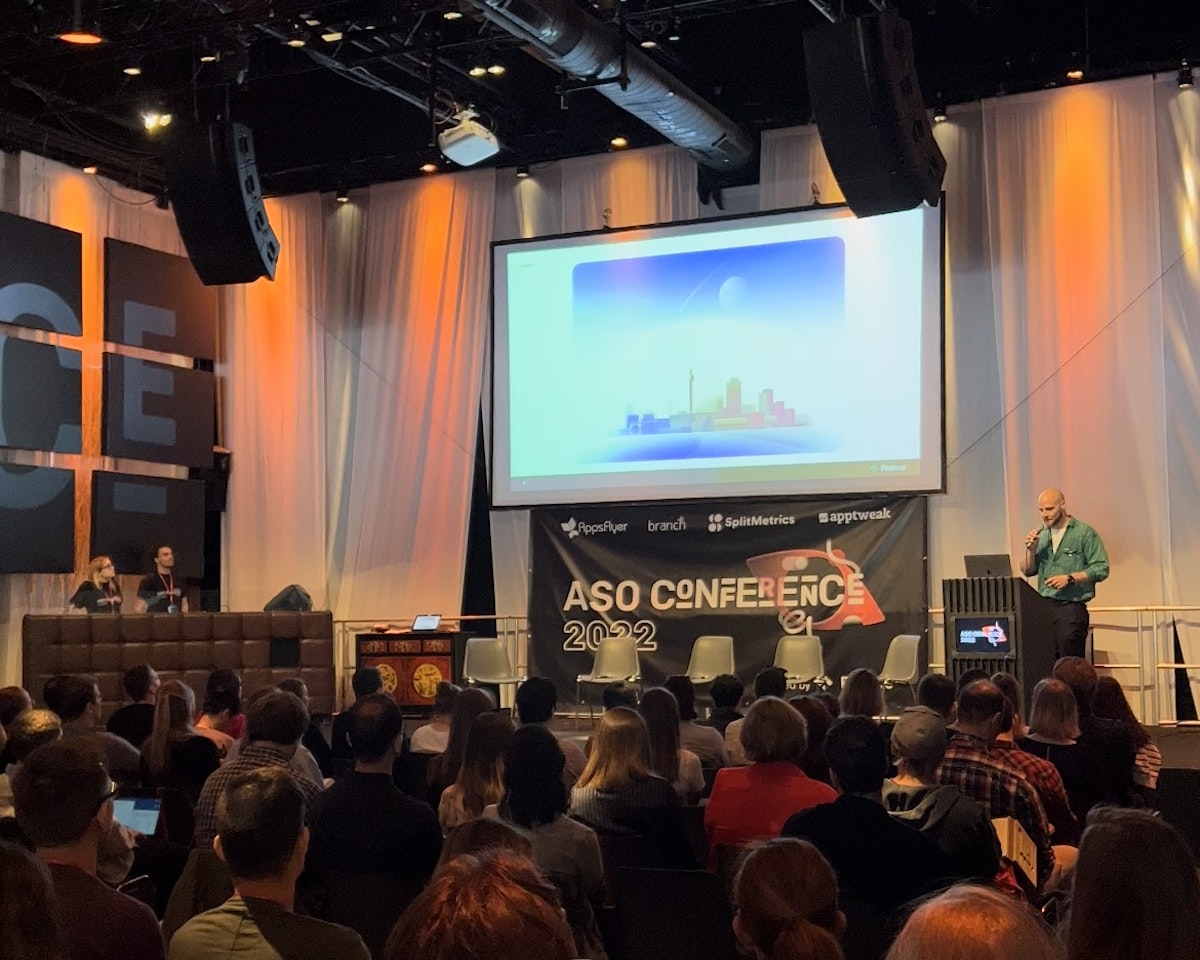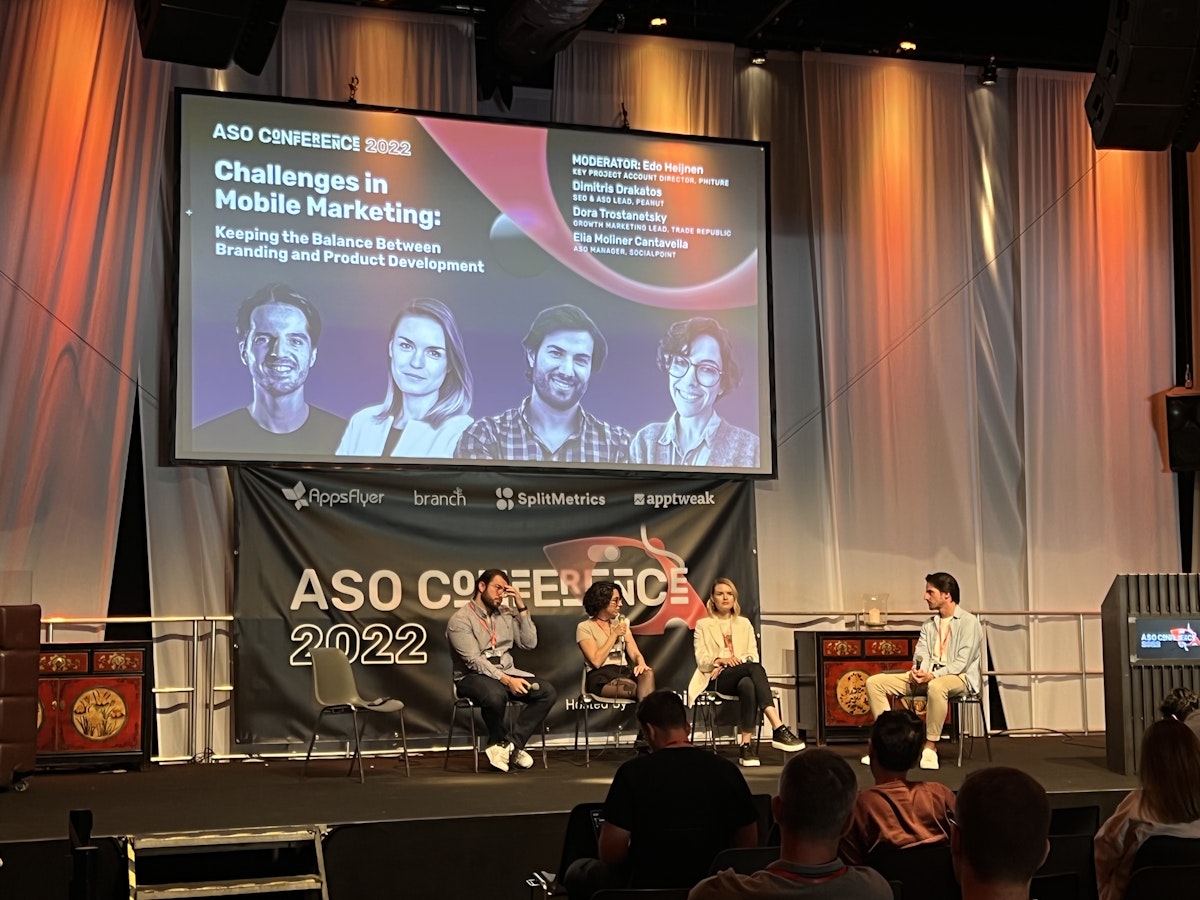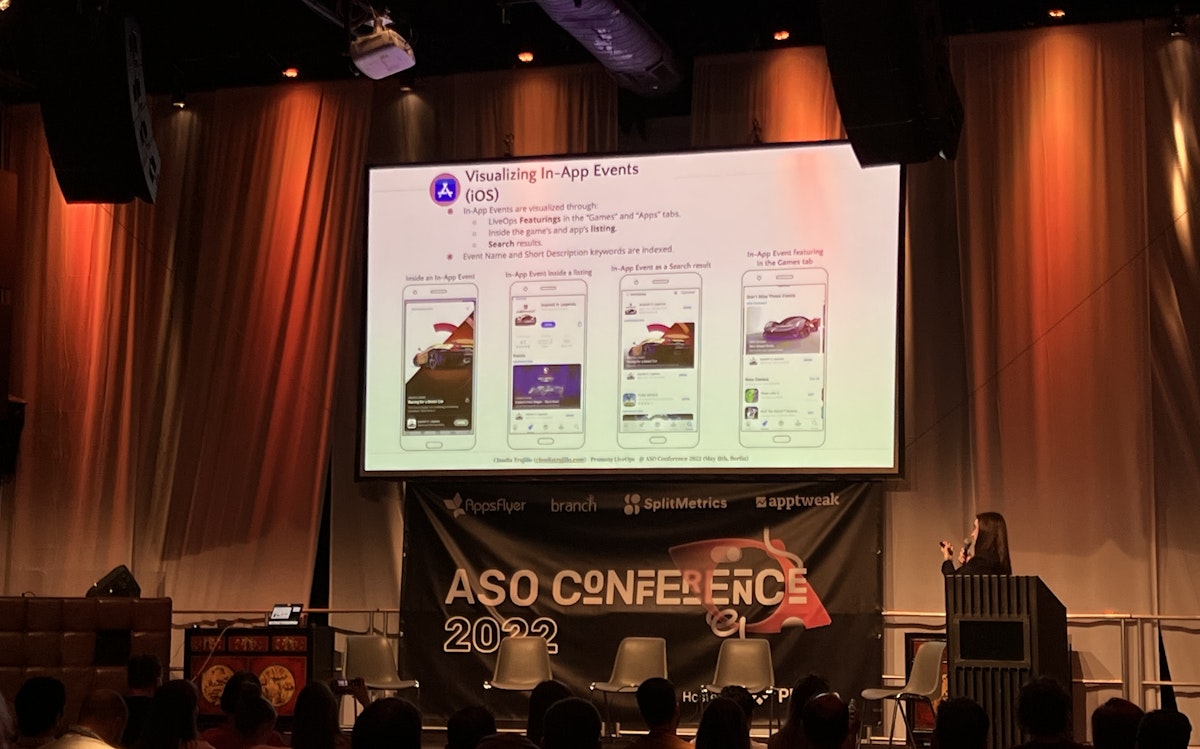
ASO Conference 2022 Recap: Talks, Topics & Insights
Last Wednesday, May 11, marked the return of the ASO Conference in Berlin after two COVID years that forced organizer and consulting agency Phiture to host the conference online. As expected, the event was dedicated to ASO education and knowledge sharing within the community, with a series of talks and workshops covering many hot topics and ASO insights.
AppTweak was proud to sponsor the event, exchange with attendees, and share our own learnings! Read this summary of the event to learn more about the insightful talks of the ASO Conference 2022.
Keeping ASO teams inspired in the long run
The day started with Phiture’s Design Lead, Stuart Miller, sharing his tips to maintain and re-boost creativity in ASO teams. According to Stuart, creative optimization is an ongoing process—even great creatives need regular refreshing and should be challenged for further improvements. To produce creatives that stand out from the crowd, Stuart advises marketers and designers to rely on three pillars: culture, people, and processes.
Culture
Culture can be an important part of the creative process, as good ideas are not reserved for a few select functions in the company. Don’t be afraid to bring in colleagues from various departments for creative brainstorming sessions. To make the most of these sessions, Stuart advised against analyzing suggestions on the spot to ease people into sharing ideas and be able to document all contributions; in Stuart’s own words, even an initially bad idea “can be a fertilizer for a really good one.”
People
People also have the ability to unlock creative improvements by leveraging their passions. This can be especially valuable when your app’s features and benefits could benefit from a creative refresh. For example, when Stuart’s team asked a Phiture designer with a passion for illustration to come up with a new visual treatment for Norton 360, moving away from a lifestyle-based design to city-based graphics (and also adding localization to the design, shown below) allowed Norton 360 to maintain a sense of trust and safety in their screenshots while also strengthening the app’s image of technology and modernity which helped to boost the app’s conversion rate.

Processes
Processes are a great way to support creativity; asking contributors to each compile a few ideas in a shared document ahead of the brainstorming session and pitch them to the group is a great way to help everyone get involved. Other processes include designating individuals to review new Play Store or App Store features to gather fresh information or developing disconnect processes to help recharge creativity as individuals (taking time off, exercising, etc) and as a team (grabbing a drink, having show-and-tell sessions at work, etc).
Black-hat ASO techniques and their threats
For the day’s second topic, Natalie Drozd (User Acquisition Manager at Fabulous) shared insights into the effectiveness and risks of black-hat ASO:
Keyword stuffing in Google Play metadata
As one of the oldest black-hat techniques, keyword stuffing in full descriptions is not only explicitly forbidden by Google but also widely ineffective. This is because Google is able to detect the attempt and can reject metadata submissions and nullify or penalize apps trying to improve their search result rankings in this way.
Keyword misuse (targeting other brand names)
While Natalie concedes that some apps may succeed in ranking higher for certain brand names by targeting them in their Google Play description or iOS keyword field, she regards this success as deceptive, as ranking improvements are far from guaranteed and extremely unlikely to lead to a search result position that actually delivers any extra app installs. Meanwhile, risks include the rejection of metadata submissions and receiving warnings before the store ultimately suspends the developer account.
Paid search installs
Natalie underlined the illusory efficiency of services used to purchase installs from a specific search query. Two elements undercutting this technique are apps’ (in)ability to divert users from their initial search intent, and the damage this technique brings to retention rates, which are, in themselves, considered by Google Play when determining the top search positions. As a consequence, this technique is far costlier than developers realize and has very low ROI, while risks once again include developer account suspensions.
Incentivized installs
Incentivized installs are widely ineffective, as boost campaigns meant to help apps reach the top charts of their respective category only serve the executives promoting this metric. Furthermore, users no longer rely on top charts to find apps to download and the bot negatively hurts app retention rates.
Review manipulation
Finally, regarding review manipulation, Natalie explained that the large majority of fraudulent reviews are flagged and deleted based on duplicated texts, unusual amounts of reviews from old app versions/devices/OS versions, or user profiles with stock photos. More importantly, Natalie shared that companies providing such services do not hesitate to target and extort their own clients with considerable amounts of fake negative reviews if they decide to no longer use their services.
Advanced App Store Optimization Book
Whether you’re an ASO newbie or an industry veteran, explore the foundations of ASO as well as the latest tips, techniques, and best practices for app growth success.
Making the most out of PPOs
Next on stage was Marina Roglic, ASO Manager at Popcore Games, who shared her tips on making the most of the App Store’s native A/B testing tool, product page optimization (PPO). Ever since its release, ASO practitioners have been through various stages of dissatisfaction, considering the feature does not yet rival Google’s Play Store Experiments.
Learn more about product page optimization and its importance to ASO
Tip #1: Improve collaboration between product & marketing
The first pain point Marina discussed is the fact that PPO tests end automatically when a new app version is submitted on App Store Connect. While this pain point particularly hurts apps that rely on short release cycles (once a week or once every two weeks), this can impact all ASO practitioners, as a lack of coordination with product teams can cause marketers to waste time relaunching a test that was interrupted by an app version release.
Therefore, Marina advised ASO practitioners to take this as an opportunity to better coordinate and communicate with other teams, so they can be informed of any changes in the release cycle (or other product issues that can impact ASO) and even attempt to negotiate the release frequency with the product team. An essential gem Marina shared is to remember you want your PPO test to be live for at least 9 or 10 days to ensure at least a full week of data is considered when calculating statistical significance, and the App Store tends to require two to three days to properly aggregate data.
Tip #2: Withdraw & resubmit PPO submissions after 2 days
Her second piece of advice concerned the asset review system: Though your PPO test cannot begin until Apple approves your PPO assets, app submissions that only include new store assets tend to take just a few hours to be reviewed. As such, she advises withdrawing and resubmitting any PPO submission that hasn’t been approved after two days, and avoiding submitting a PPO test just before the weekend. She also noted that tests concerning the order of screenshots do not require any approval and can start immediately.
Tip #3: Use learnings from Play Store Experiments
Thirdly, Marina shared her workaround to PPOs not providing data breakdowns per country or language when running across more than one locale at a time. Rather than running tests completely independently between the App Store and Play Store, she advises ASO practitioners to take learnings from Play Store Experiments and validate them first for the App Store’s default locale, then for tier-1 markets (if successful), before finally applying the winning concept to all markets without testing for less significant regions afterward (instead only monitoring their conversion rates in the console).
Tip #4: Keep an eye on unique impressions
Finally, Marina warned the audience that online sample size calculators are unlikely to help determine whether a test has enough statistical power, as Apple’s PPO sampling method relies on a Bayesian model, meaning you may not get the same amount of impressions for all variants of your test. Her advice is to run your tests until the winning variant drives at least equal the number of unique impressions as your app’s average daily unique impressions.
ROI measurement of ASO activities & knowing how much to invest
Next, Aleksandra Zivkovic (CRM & ASO Manager at Nordeus) shared his insights into measuring ROI and efficiently investing ASO resources.
The first thing she noted was the importance of planning and prioritization ahead of an app/game launch, starting by aligning various marketing teams with the target, value propositions, and brand guidelines. Then, (still ahead of the launch) the ASO team should elaborate a creative testing plan based on strong hypotheses and the complete value of each test, based on:
- The visibility of the asset tested (i.e., icons are seen by all users; after, you should consider which screenshots, videos, and feature graphics will actually be visible to users without having to scroll).
- The markets where the game or app is expected to get the most traction.
- The time needed for a localized test to reach statistical power in each market.
- The anticipated consistency with other marketing activities around the time of the test.

Once your plan is in execution and along your app’s lifecycle, ROI measurement can be approached in two ways: holistically or focusing on one specific activity.
Benefits of holistic ROI measurement
Holistic ROI measurement makes the most sense for collaborative marketing teams that regularly align on their activities to amplify each campaign across all channels, and are therefore able to agree to measure ROI across all channels at once. The benefits of this approach are the ease of calculating costs, registrations, and average revenue per user (ARPU), and the possibility to make decisions with predictive lifetime value (LTV) modeling. Aleksandra noted that ROI estimations can still be made without predictive LTV modeling by using day-7 LTV and a multiplier per market, though this method will likely be less precise.
Benefits of activity-specific ROI measurement
Meanwhile, activity-specific ROI measurement helps marketers better evaluate the impact of specific teams. It relies on the same logic as ARPU and LTV estimations, but with the added challenge of calculating baselines for each activity, thus necessitating the complete knowledge of marketing schedules and perhaps requiring marketing teams to undergo “freeze” periods to better set baselines for their respective activities.
Challenges in mobile marketing
Keeping the balance between branding and product development
The first panel talk of the day was moderated by Edo Heijnen (Key Project Account Director at Phiture) who asked Dimitris Drakatos (SEO & ASO Lead at Peanut), Dora Trostanetsky (Growth Marketing Lead at Trade Republic), and Elia Moliner Cantavella (ASO Manager at Socialpoint) to shed light on how their companies navigate three essential challenges in ASO: reporting, communication, and structure.
The panel consistently showed the connection between all three challenges. For example, in the case of reporting and lacking clear metrics for separate marketing activities, it’s better for companies to align the timing of activities that relate to one project to then measure their impact holistically. This leads all stakeholders to accept that, in most (if not all) cases, improvements and losses have multifactorial explanations. As a result, formulating a hypothesis as to how a singular activity reflects on multiple metrics becomes easier after identifying an event in holistic data.
Elia shared that Socialpoint was experiencing good success with this, especially by creating temporary squads for each marketing project and calling on individuals from different teams to collaborate towards a specific goal. Despite the added challenge of managing resources from multiple squads at the same time, Elia was able to legitimize ASO at her company and strengthen a dedicated ASO team, instead of debating ASO ownership between brand and product teams.

Comparing structures, Dora explained that Trade Republic works in pods with ASO attached to Growth and working closely with a Paid team (for Apple Search Ads), and maximizing skills by having the same creative designer in charge of store and website assets. She also noted the importance of the company’s top executives to not only clarify ownership of different tasks but also to set a culture of involving people from different backgrounds in the same projects.
Dimitris explained that for smaller companies where the ASO team is usually a single person, the key is to first educate various stakeholders (e.g., designers) about ASO, taking the time to properly introduce the topic and provide context before soliciting colleagues to start working on a specific project. He also highlighted the importance of aligning the ASO team’s OKRs and KPIs with the company’s global goals and making consistent efforts to be transparent and communicate wins to gain goodwill and raise interest.
Finally, the panel’s main advice was to break the silos around ASO and think more about funnel metrics with the user perspective in mind so everyone’s work could contribute to providing clear value.
ASO strategy: Behind the scenes
The ASO Conference’s final morning presentation was delivered by Catherine Sibirko, ASO Team Lead at G5, who shared her thoughts on the challenges of formulating ASO strategies.
Catherine began by underlining that, despite frequent changes in the industry, the fundamentals of ASO remain relevant, and even a single person running ASO should formulate a proper strategy for the company. Doing so will help this individual ensure they maintain their focus on priorities and also better communicate the importance of ASO with other stakeholders.
Since each company should have its own ASO strategy, Catherine presented her six steps to follow to craft an effective ASO strategy:
Tip #1: Plan
Start by mapping all relevant information before getting started to isolate the most relevant things to prioritize. Mind maps can particularly help to reflect a decision tree structure (which store/market/metadata elements to optimize first, how often, etc).
Tip #2: Set goals
Setting goals is essential to measure results. As a result, it’s worth keeping a critical eye on goals and making sure they help to drive new actions (if the goal is to get never-achieved-before results).
Tip #3: Define and communicate efficient processes
Predefine a set of actions (and orders) to allow the strategy to be executed at an optimal speed and with enough transparency to reinforce trust within the team and among stakeholders.
Tip #4: Maintain structure
As ASO is an infinite-horizon game, storing data is essential and requires clear structures. Structure allows past work to maintain its value, despite the lapsed time.
Tip #5: Be smart with analytics
Despite already being at the heart of ASO, analytics tend too often to be taken at face value. Catherine recommended marketers use multiple points to double-check crucial results and that they avoid rushing into applying A/B test results and not confirming that changes help to increase CVR even after a few weeks.
Tip #6: Always communicate
As mentioned by the majority of speakers at the conference, the communication of needs, actions, results, and opportunities is more essential than ever, with ASO often at the crossroad between multiple teams.
As a bonus, Catherine also highlighted that the value of ASO goes beyond direct results when done with transparency and in collaboration with other teams; the ability to stay up to date and try new things can be crucial to an app’s competitive advantage.
How ASO can support business growth in mobile-first companies
The afternoon started with a panel discussion moderated by Peggy Ann Salz and filled with other prominent members of the ASO Community including Oksana Iarosevych (ASO Team lead at G5 Games), Nika Grigoreva (Senior Performance Marketing Manager, ASO and Search at Ada Health), George Natsvlishvili (Organic Growth Manager at Air Apps) and Thomas Petit (ASA and Analytics Consultant).
Tip #1: Educate all involved stakeholders about ASO
The first topic raised was the importance of educating stakeholders about ASO. For example, Nika explained how educating designers about ASO (beyond a basic understanding of store guidelines) helped the team better understand their impact and the context in which their work may be solicited.
In response to this, George highlighted that progressive training on ASO requires time and effort but helps with both company buy-ins and also advances the team towards complex ASO challenges. For Thomas, education is a priority for accurate expectations and should excite ASO teams, as it not only helps them position themselves at the center of the company but also creates opportunities to understand the work of other teams to better collaborate in the future.
Tip #2: Consider A/B test losses necessary
For instance, education is required to communicate losses in creative experiments. According to the panel, ASO practitioners should welcome A/B test losses and be suspicious of people claiming very high win rates. Experiment losses can be great to help reorganize the experiment backlog, and should not be branded as failures but accepted as part of the process. Moreover, one great success can more than compensate for unsuccessful trials.
Tip #3: Try new app store features as soon as possible
To strengthen your competitive edge, George and Thomas pointed to the benefits of being an early adopter of new features on the App Store and Google Play, as larger organizations are typically slower than start-ups to adopt them. Nika and Oksana also raised the value of localization and culturalization, as better understanding the different needs of users in different countries helps to frame product messages to user expectations.
Tip #4: Question and listen to your customers’ needs
However, all panelists agreed that ASO has a more important role to play throughout an app’s full lifecycle than only for user acquisition. For instance, marketers should now look more into opportunities to appeal to returning users or leverage funnel views to better understand what users value. By customizing messages to appeal to different users, you may see engagement and/or featuring opportunities grow.
Rethinking and organizing for ASO in 2022
Next, I (Simon Thillay, Head of ASO at AppTweak), took to the stage to share insights as to why we should begin rethinking ASO in 2022 and reviewing how companies structure teams. For the first point, I considered how the definition of ASO has evolved since 2014:
- Although the elevator pitch that ASO would be the “SEO of mobile apps” helped create opportunities in the early days of the App Store, the truth was quickly revealed as, unlike SEO, ASO was constricted to one page per store and language, of which developers did not even have complete control.
- The first holistic definition introduced with the ASO Stack also partly became outdated, as Apple and Google increasingly blurred the distinction between organic and paid channels.
- Finally, major changes brought by iOS 15 and new Google Play features have marked the end of the one-page-fits-all approach that has been at the core of ASO until now. Google Play promotional content and iOS 15 in-app events have now opened the door to leverage ASO in favor of retention and engagement rather than only for new user acquisition.

In parallel – or rather, because of these changes – hiring for ASO should now focus less on direct ASO experience and more on the combination of useful skills, including data mining and analysis, marketing, and product management. The combination of these skills also demonstrates that ASO has become a subset of Growth and can therefore be organized similarly. Each company should find the most appropriate structure between the two most likely: ASO specialists working as a pod across various teams, or one single ASO team that assumes full ownership of any change that goes live on the store.
Beyond choosing the right structure to help determine ownership, another essential consideration is the need to understand the different forms of ASO and prioritize projects with the best ROI. To that end, I advocate that companies consider hiring/promoting ASO strategists whose role is to interact across teams and specifically identify the new features that match that specific company’s business interests and strategy.
Understand how to build and structure a powerful ASO team for your app company
Boost your game visibility via in-app events & promotional content
Claudia Trujillo (ASO Expert at Gameloft) was next on stage to give an overview of iOS 15 in-app events (IAE) and Google Play promotional content. Beyond the technical specifications, Claudia highlighted three main points regarding the setup phase:
- While certain metadata elements of your IAE (the event name and short description) are indexed by the App Store search algorithm and can therefore contribute to increasing your app visibility, metadata for Google Play promotional content is not indexed at all and should therefore only be optimized for conversion.
- Another major difference between the features is that in-app events allow developers to specifically target new, active, or lapsed users, whereas promotional content is shown to all users, instead letting developers offer users rewards.
- A key benefit of both features is being able to preview the event on the platform before it starts to build excitement and maximize engagement on day 1.
Discover these top strategies and best practices for iOS 15 in-app events

To measure event performances, Claudia advises marketers look both at data from the store consoles and from third-party tools. She specifically identifies reach (impressions per channel, keyword rankings, featurings, and category rankings), acquisitions (redownloads and app updates), conversion (opens and sessions), and even monetization as the different steps of the funnel you need to monitor. It’s also worth keeping an eye on your ratings and reviews during the event, as well as product vitals in the case of Google Play promotional content (previously LiveOps), as you want to make sure your app doesn’t run into unexpected issues while the event is running and loses opportunities to be promoted by the store.
How influencer marketing can uplift keywords on the App Store
Lucia Aguilar, CEO & Founder at Tatam, was the last speaker at the ASO Conference 2022 and presented a case study conducted with Phiture to measure how influencer marketing affected store performances for Adobe Lightroom.
After deciding on three core keywords to target (“photo editor,” “filters for picture,” and “presets”), Tatam organized a briefing to nudge influencers to not only promote the app but to use these specific keywords in either their videos or in the video description. The influencer campaign then went live in Brazil, Germany, and the US, and drove the following results:
- In all countries, Adobe Lightroom improved its ranking in the top charts.
- Adobe Lightroom saw both its impressions and downloads increase with differences in value per market: CTR and install rates were both high in Brazil, campaigns in Germany had a high CPM but also good conversion, and campaigns in the US mostly had a positive impact on reactivations.
- Keyword rankings remained stable or slightly improved, though results were not significant enough to show a definite correlation with the influencer campaign.
After a day filled with insightful talks, valuable insights, and exciting networking, the ASO Conference 2022 definitely suggests that ASO will continue to grow rapidly over the next months and years.
Whether you’re an ASO beginner or an industry expert, discover how AppTweak can help boost your app growth strategy on the App Store and Google Play.




